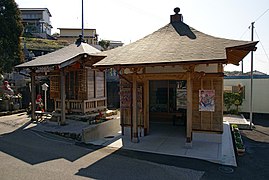Zenraku-ji
The Zenraku-ji ( Japanese 善 楽 寺 ), with the Go Dodosan (百 々 山) and Tōmyōin (東 明 院) in the city of Kōchi ( Kōchi Prefecture ), is a temple of the Buzan branch (豊 山 派) of Shingon Buddhism . In the traditional count it is the 30th temple on the Shikoku pilgrimage route .
history
According to tradition, priest Kūkai is said to have visited the area during the Daidō era (806-810), after the death of Emperor Kammu , and worshiped the Zenraku-ji as a side temple of the shrine, in which the Shinto deity Takakamo ( 高 鴨 大 明 神 ) worships was established. The connection with Shintoism then remained over the following centuries.
At the beginning of the Edo period , the 2nd Prince of Tosa, Yamanouchi Tadayoshi ( 山 内 忠義 ; 1592–1665), promoted the temple, which came to its heyday. At the beginning of the Meiji Restoration , the temple was demolished as part of the initially strict separation of Shinto and Buddhism. It was finally rebuilt in 1929, followed by a difficult collaboration with another temple, until the Zenraku-ji was determined on January 1, 1994 as the 30th temple in the list of the Shikoku pilgrimage.
investment
The small temple has a main hall made of modern material (本 ō, Hondō; 1) and to the left of it the hall for the worship of the temple founder, the Daishidō (大師 堂; 2). A specialty is the holy jizō (3) in front of a plum tree. Next to it are two tiny places of prayer (4). There is also a cemetery (F) on the temple grounds.
photos
literature
- Kōchi-ken kotogakko kyoiku kenkyukai rekishi bukai (Ed.): Zenraku-ji . In: Kōchi-ken no rekishi sampo. Yamakawa Shuppan, 2006. ISBN 978-4-634-24639-3 . Page 47.
- Oguri, Doei: Kukai. Shikoku hachijuhachi kosho no arukikata. Chukei no Bunko, 2011. ISBN 978-4-8061-4067-2 .
Web links
Coordinates: 33 ° 35 ′ 30.9 " N , 133 ° 34 ′ 39.2" E
← Previous Temple: Kokubu-ji | Zenraku-ji | Next temple: Chikurin-ji →





